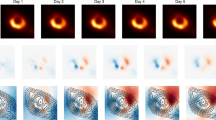Abstract
The observations of comet Halley by the Halley Multicolour Camera (HMC) on board the European Space Agency's Giotto spacecraft were supported by an extensive ground-based observational programme using the same filter set1. The intention was to place the transitory but detailed observations of the encounter in the frame of ground-based observations, thereby yielding the evolution of the comet. The importance of this connection has increased because of the limited information on the three-dimensional extent of the cometary nucleus and its environment retrievable from HMC observations, caused by the communication loss just before closest approach. Here we model dust jets visible on the ground-based images, assuming active sources on the rotating nucleus. We found no fit using the rotation axes so far derived from nucleus observations. A mean instantaneous spin axis, at the time of the Giotto encounter, pointing towards α = 328°, δ = −63° is consistent with both ground-based and HMC observations of the dust. We have confirmed a rotation period of about two days.
This is a preview of subscription content, access via your institution
Access options
Subscribe to this journal
Receive 51 print issues and online access
$199.00 per year
only $3.90 per issue
Buy this article
- Purchase on Springer Link
- Instant access to full article PDF
Prices may be subject to local taxes which are calculated during checkout
Similar content being viewed by others
References
Cosmovici, C. B. et al. Eur. Space Ag. spec. Publ. 250 (II), 375–379 (1986).
Cosmovici, C. B., Mack, P., Craubner, H. & Schwarz, G. Eur. Space Ag. spec. Publ. 250 (II), 151–155 (1986).
Green, S. F. & Hughes, D. W. Eur. Space Ag. spec. Publ. 250 (II), 157–161 (1986).
Thomas, N. & Keller, H. U. Astr. Astrophys. 187, 843–846 (1987).
Keller, H. U. et al. Astr. Astrophys. 187, 807–823 (1987).
Thomas, N. & Keller, H. U. Bull. Am. astr. Soc. 19, 866 (1987).
Wilhelm, K. et al. Eur. Space Ag. spec. Publ. 250 (II), 367–369 (1986).
Sekanina, Z. Comet Halley 1986: World-wide investigations, Results and Interpretations (Ellis Horwood, Chichester) (in the press).
Sekanina, Z. Nature 325, 326–328 (1987).
Julien, W. M. Nature 326, 57–58 (1987).
Millis, R. L. & Schleider, D. G. Nature 324, 646–649 (1986).
Author information
Authors and Affiliations
Rights and permissions
About this article
Cite this article
Keller, H., Thomas, N. On the rotation axis of comet Halley. Nature 333, 146–148 (1988). https://doi.org/10.1038/333146a0
Received:
Accepted:
Issue Date:
DOI: https://doi.org/10.1038/333146a0
This article is cited by
-
Comets
The Astronomy and Astrophysics Review (1993)
-
Comets
The Astronomy and Astrophysics Review (1993)
-
Indication for precession of comet Halley's nucleus from dust tail analysis
Earth, Moon and Planets (1990)
Comments
By submitting a comment you agree to abide by our Terms and Community Guidelines. If you find something abusive or that does not comply with our terms or guidelines please flag it as inappropriate.



